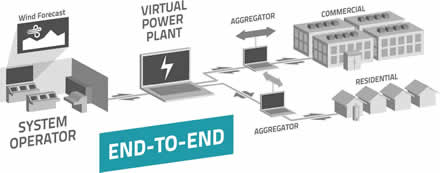Electricity Load Control Demonstration
Lead proponent: New Brunswick Power Corporation
Location: The Maritime Provinces:New Brunswick, Nova Scotia and Prince Edward Island
CEF contribution: $ 15.6 M
Project total: $ 32 M
Project Background:
Atlantic Canada has one of the best wind regimes in the world. This wind regime provides significant opportunities for ongoing and expanded renewable wind generation. However there are challenges to utilizing this resource effectively, particularly as the portfolio of wind generation increases relative to flexible and controllable conventional generation assets. Variability of the wind generation profile coupled with the existing variable demand profiles are currently balanced with ancillary services which are provided by on-line and off-line generators. Load management via a virtual power plant (VPP) has the potential to reduce the requirement for ancillary services from existing assets.
Text version
Figure 1
PowerShift Atlantic Virtual Power Plant – How it Works!
The Power Shift Atlantic (PSA) solution involves four primary actors. Moving from left to right you have the System Operator (SO), Virtual Power Plant(VPP), Aggregators and Customers. This diagram illustrates the end-to-end connectivity from the SO who sends and receives information via the VPP. The VPP exchanges information with the aggregators on the amount of load to be shifted based on the request from the SO as well as the aggregator’s forecast and capabilities. The Aggregators communicate to the various commercial and residential customers through a series of intelligent hardware and software solutions installed at the various commercial and residential customer locations.
The “PowerShift Atlantic” (PSA) project set out to demonstrate one of the world’s first fully grid-integrated VPPs in order to allow for more effective integration of wind power. Unlike typical demand response services, the VPP would use load and wind forecasting and aggregation capabilities to perform near real-time load shifting of commercial and residential loads, as well as provide new ancillary services to the grid. New Brunswick Power Corporation (NBPC) led a collaborative consortium of utilities (Maritime Electric Company Limited, Saint John Energy, and Nova Scotia Power Incorporated) along with the University of New Brunswick (UNB) to apply for funding from the Clean Energy Fund for the project. PSA was awarded $15.6M to help the partner utilities build a relationship with customers, and intelligently shift customer loads to allow for more effective integration of wind generation – a forerunner towards a paradigm shift of “load following generation” instead of the traditional “generation following load”.
Results:
More than 1400 combined residential and commercial customers, with approximately 17.3 MW of connected load, participated in the demonstration project. Intelligent components were installed on qualifying equipment (“end uses”) at customer sites. All eligible end uses (for instance, water heaters or commercial refrigeration units) had energy storage capability and did not rely on a constant supply of energy to function. Each intelligent component continuously communicated with an aggregator, which used both hardware and software to collect real-time information and combined end uses into groups or “loads”. Aggregators are third party entities contracted by the participating utilities to perform energy management and shift energy usage patterns in a manner unnoticeable to the customer.
The VPP is an intelligent energy management system that works with the aggregators and the region’s system operator to direct the shifting of customer load and allow for optimal use of wind generation on the system. It is one of the core components of the PSA solution (otherwise known as the Intelligent Load Management or ILM system).
The Project successfully demonstrated the technical feasibility of customer load shifting through an ILM system. Scaled up versions of the ILM were modelled using a Plexos modelling tool to determine the capabilities and benefits that could be offered with a significant amount of controllable load (a variable percentage of the total connected load). The PSA solution still needs to overcome challenges to become viable and cost effective for utilities. Nonetheless, residential customers were generally (80%) satisfied with recruitment process, installation and overall program experience.
Benefits to Canada:
PSA provided participating utilities the benefit of developing a better understanding of their customers. The Project also enabled participating utilities to identify areas where technical and business process modifications would be required to roll out an ILM. These learnings would benefit all utilities operating in Canada and enable more effective integration of wind generation, as VPPs are replicated across the country.
Next Steps:
NB Power will develop a “Reduce and Shift Demand (RASD)” strategy where PSA customers will have the opportunity to participate in RASD programs as they become available.
Page details
- Date modified:
